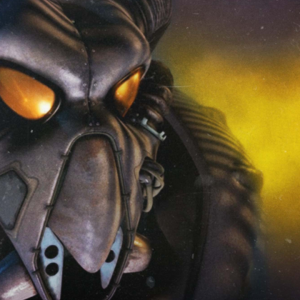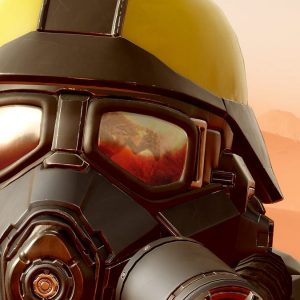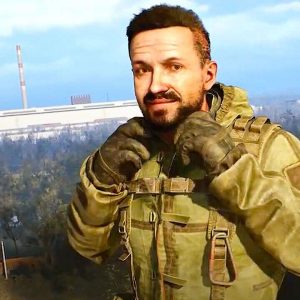We all have those memories of games – hopefully only figuratively – scaring the crap out of us.
If you’ve ever played a survival horror game, you no doubt vividly remember a specific moment that scared the crap out of you – hopefully only figuratively. Though given the millions of gamers who have walked the hallways of the Resident Evil mansion and experienced that window-shattering surprise encounter with the zombie dog, it’s entirely possible that some have had to literally reach for a change of underpants. If that happened to you, please don’t share it in the comments.
Whether it was Man Bat so rudely introducing himself in Arkham Knight, the moving mannequins in Condemned, or coming face-to-face with Lisa in Kojima’s P.T., every gamer has a different story of when and how a video game first got them – like, really got them – with a jump scare.
Mine was in 1985. And I know exactly whom to thank: George Lucas.
If you’re reading IGN, you know the name – but you might not know the game or the development team behind it that ran with his sage advice and ensured that my story is shared by many veteran gamers. Turns out, when people talk about 1985’s Rescue on Fractalus, the jump scare is the first thing they mention.
“People usually tell me: ‘I remember the first time a Jaggi popped up. I was playing in the dark with a bunch of college friends and we had a big speaker setup and a Jaggi popped up and I fell off my chair. And people came to my door asking if I was okay,’” project lead and former Lucasfilm Games designer David Fox told me. “There was someone who said their 5-year-old was playing it and the kid ran out of their house screaming ‘Mommy, there’s a monster in my computer! Help!’”
“I kinda feel bad for that part of it. But not too bad,” he adds.
But before we get to that memorable moment – most likely the very first jump scare in gaming history – you should know that Rescue on Fractalus is so much more than that unexpected wake-up call. And just to be clear: nobody got scared by pixelated graphics. Though named after the jagged stair-step edges seen in lower-resolution game graphics, the Jaggis in question are green, bug-eyed aliens intent on your destruction.
Rescue on Fractalus! is a first-person cockpit shooter that has you fly your Valkyrie spacecraft over a fractal landscape (hence the name) in search of downed pilots. The game made quite an impression on me when I played it as a teenager – seeing what I thought were smooth 3D landscape graphics on my Atari 8-bit computer was a bit of an epiphany. “Is this where games are going?”
Originally codenamed “Rescue Mission” and “Behind Jaggi Lines”, Fractalus was one of two initial games pioneered by the games group at Lucasfilm, which would become Lucasfilm Games and later LucasArts. The other, Ballblazer, was an equally exciting demonstration of how advancements in technology could have a lasting impact on game design. I can’t tell you how many hours my friends and I sank into this super-speedy split-screen vehicular sci-fi soccer game. But suffice it to say, the first two Lucasfilm games made quite the splash with technology-obsessed computer gaming fans and that streak continued with later releases, like The Eidolon and Koronis Rift.
All Roads Lead to Star Wars
Rescue Project leader David Fox and his wife Annie were running a public-access computer center non-profit in Marin County, north of San Francisco when he first crossed paths with Lucasfilm while researching computer-generated special effects for a book on computer animation he was writing at the time. Fox got the inside track on Star Trek II: Wrath of Khan’s famous fractal-based planet-transforming sequence, known as the Genesis Effect, and made friends with its creator and later Pixar co-founder Loren Carpenter.
The first half of Fox’s book, Computer Animation Primer (free PDF also available), focuses on the history and tools of computer animation, but the second half dives even deeper and looks at the Atari 800 and the possibilities of doing computer animation at home using BASIC and assembler language. The book, delivered to the publisher but still awaiting publication, turned out to be the perfect door opener at the Lucasfilm Computer Division’s newly founded Games Group. Supported by a million-dollar deal with Atari that offered the computer maker right of first refusal on new game projects, the company took a chance on David and he joined in 1982.
David saw it as a path to be part of the Star Wars creative universe — he never imagined there’d be a place in the company for him given he lacked the skillset for film production or special effects work. “I saw Star Wars four years earlier and loved it. I was a huge fan and I just wanted to get into those movies somehow and this seemed like the best way to get a job at Lucasfilm.”
He didn’t waste any time. Even before the studio was properly set up and he was still sharing an office with Carpenter, he pitched what he calls a “Rescue-type Star Wars game – something with the impact of Star Raiders on the Atari 800 but with great sound and spectacle.”
But Lucasfilm had already licensed Star Wars to other companies, with Atari and Kenner/Parker bros. splitting the rights for arcade and home games, respectively.
“I said okay, I still want to do this game – I just won’t call it Star Wars,” recalls Fox. “So I asked Loren if he thought it’d be possible to take his fractal landscape technology and make it work on an Atari 800. He laughed and said ‘no, no way.’”
But Carpenter came back the next day and the “no” had already turned into a “maybe.” Fox provided him with an Atari 800 computer, manuals, and instructions on how to program in 6502 assembly language and three days later Carpenter came back with an Atari 800 prototype that showcased flying through a landscape with randomly-generated fractal mountains.
“The framerate was six or eight frames per second… Which was amazing at the time. Microsoft Flight Simulator was two or three frames per second. This was, like, wow – this is amazing!”
Fox got to work on creating a design document that outlined both the use of fractal technology and many of the gameplay details that would make it into the final game. “Any similarities between this game and the rescue scene on the ice planet Hoth are purely coincidental,” he wrote in the 1983 doc. He also got out the graph paper and sketched some early designs, including the Valkyrie spaceship’s cockpit, which took heavy inspiration from Luke Skywalker’s ship of choice, the X-Wing.
While Fox was set to bring the excitement of Star Wars to computer gaming, he also wrestled with what he calls his “hippie pacifistic tendencies.” His original design outlines a non-violent flight action game – one without a fire button or any shooting at all. His idea was that you could get enemy saucers to chase you and you could lure them into dangerous terrain and cause them to crash into canyon walls.
The Emperor is Coming Here?
When the Rescue and Ballblazer projects reached beta, Star Wars director and head of Lucasfilm himself, George Lucas, wanted to try the games.
Fox recalls that George picked up the joystick and immediately said “How come the fire button doesn’t work? Where’s the fire button?”
Fox told him about his idea of not having direct combat and Lucas asked if it was a gameplay decision or a philosophical decision: “Did you do this to make a better game or due to your beliefs?”
“And I said, ‘well, more the latter, I guess.’ George said: ‘I want a fire button.’ And he was right. The other thing he said was: ‘What if, if everyone once in a while, the pilot you rescued turns out to be an alien. And maybe he jumps up, or something like that.’”
Fox says the suggestion threw the team for a loop. They asked themselves if it could be done, technically. “There were issues with framerate, there were issues with storage, with trying to get more animation into the game,” Fox said.
The project grew in scope, and with it the team. Gary Winnick joined to help design and create animations for the Jaggi alien character. Charlie Kellner, who worked on flight dynamics, music, and sound, and Peter Langston, Games Group Leader, then added the finishing touches and brought my childhood nemesis to life by coming up with the Jaggi pop-up sound on a MIDI keyboard. The creature looks harmless today, but trust me, when you’re not expecting a visit from a Jaggi, it’s quite the shock.
When Jaggis Attack
Rescue on Fractalus! has you rescuing crashed pilots while fending off enemy attacks for quite a while until “that moment.” You use your radar to track one down and then carefully land – all handled seamlessly and in real time – turn off your engines and wait for the pilot to approach. You then hear a knock at the ship’s door as the now invisible pilott is asking you to open the hatch and let them in. If you wait too long, the knocks fade and get slower – and eventually the pilot dies. But open the airlock too early, and you may have inadvertently opened your safe space to a murderous alien.
The trick is that the game lulls you into a sense of security. For a full seven levels, Rescue on Fractalus! is all about rescuing your fellow pilots. The loop becomes routine. Land. Turn off engines. Open hatch. Successful rescue. The marketing kept the jump scare secret – there’s no mention of it in the manual other than a cryptic transmission from a pilot on the back that something went wrong during the mission. That’s it.
Then, randomly, a Jaggi – nearly indistinguishable from a benign human pilot – approaches your ship. If you wait for the knock, the Jaggi jumps up in front of your screen, perfectly timed with a horrific sound and starts pounding on the cockpit. Here’s a brief clip of the moment on YouTube. Turn up the volume and watch. The only way to get out of this situation is to quickly turn on your ship’s engines and obliterate the intruder – something that’s incredibly difficult to do when you’re trying to pick yourself up from the floor after falling off your chair.
Worse, if you carelessly open the hatch early and let the Jaggi in, it’ll tear apart your ship – audible, but unseen by you since he’s in the cargo hold – and can only be killed by flying into space and venting the airlock.
The only thing that shook “adolescent me” awake as effectively as Rescue’s Jaggi-in-the-Box moment was Brian DePalma’s “hand from the grave” ending to Carrie – it’s that well done. Thanks for the nightmares, George. The commitment to keeping the game’s most memorable moment completely secret is beyond admirable. Even the 1984 Lucasfilm Games press conference, thankfully preserved here in video form (it’s awesome, watch it), makes no mention of the alien encounter.
The Other Big Scare
I’d be remiss if I didn’t point out the “other scary” part of the Rescue on Fractalus! story. I remember the controversy very well, because even in the pre-internet days it was apparent hat something had gone terribly wrong with Rescue’s release. According to Fox, when the game was complete, Atari planned to show it at Summer CES in 1984. In case you’re not keeping record, that’s a year after the great, the oft-cited – the infamous – video game crash of 1983. After a year of dropping sales and major flops, Warner, Atari’s parent company, put the publisher and developer up for sale – and Jack Tramiel, of Commodore Computers fame, snatched up the consumer division and created the Atari Corporation. The other half of the company became the development studio, Atari Games. And like that, Rescue’s future was up in the air.
Gaming history can be a little hazy and it’s not entirely clear what happened next and when — the exact release date for Rescue on Fractalus! is also lost to time. But Fox believes that the 5200 cartridge version was initially released in 1984 by Atari, but then pulled from distributation after Tramiel bought Atari. With Atari Corporation changing focus, Lucasfilm managed to find another interested party, Epyx, who signed up to publish both Rescue on Fractalus! and Ballblazer on disk – but not on cartridge. And while the game was being reworked for disk – which included adding the load screen animation and copy protection – Lucasfilm shared near-final game code with potential Atari 5200 version publisher Atari as well. Code designed for a cartridge version – on easily replicated disks – that didn’t include any copy protection whatsoever.
Within a week, both games were widely available across all the BBS Atari User Groups. It’s unknown who leaked the game, but it no doubt had a meaningful impact on both demand and sales for years to come. Before gamers ever had a chance to buy Ballblazer and Rescue on Fractalus!, they were downloading and trading the games for free under their development names, Ballblaster and Rescue Mission/Behind Jaggi Lines.
“It was devastating,” David Fox told me. “All of us who lived through that were always adamant about copy protection and the importance to combat piracy since we got burned by it.”
Perhaps there’s a little bit of poetic justice in the fact that the people who pirated Rescue on Fractalus didn’t even receive the hint about the green helmet because they didn’t have an instruction manual. I’d like to think that they fell off their chairs just a little harder.
While feedback from George Lucas may have shaped the game and made it more memorable, Rescue on Fractalus! was created by a small team of smart developers and artists who came up with many concepts clearly ahead of their time. It features an animated load screen that shows Valkyrie ships exiting a giant mothership – and when the game is ready to play, you jump right into the cockpit and transition smoothly from launch bay to space, to planet, and right into its world of fractal canyons. Its sound effects design still holds up today – as does the great, Ride of the Valkyries-inspired score by Charlie Kellner. It’s got day/night cycles. It even simulates your pupils contracting – after getting hit and seeing a bright flash on screen, the devs deliberately darken the screen for a short time. Fox’s initial design document from 1982 even asks the question: “is it possible to include a processor/circuitry/extra RAM inside a VCS cartridge to produce much better games that the machine could ordinarily display?”
A mere four years after Defender and almost a decade before Star Fox, the young crew at Lucasfilm Games pulled off something remarkable worth knowing and remembering today.
Where Can You Play it Now
Outside of emulation, the best way to play Rescue on Fractalus! is still on an Atari computer or the Atari 5200 (Atari did eventually reissue a cartridge version, though the planned 7800 version never materialized), but a number of lesser ports – Apple II, C64, Amstrad, Tandy, ZX Spectrum – exist, too. Copies on eBay run the gamut from $20 to hundreds of dollars. Sadly, no modern collections or conversions exist as of yet, which is no doubt why a fan remake project sprung up in Australia and saw its free 1.0 release in 2020. You can check out more information about the impressive conversion on its website – it’s even playable in VR. As for Fox’s recommendation: “Other than the fan version, the best Rescue experience was playing it on an Atari 800 with a superclocked 6502 chip. Framerate was around 60fps and was how I always imagined the game should be.”
A remake for iPhone was originally planned by the original team, LucasArts, and retro experts Other Ocean. According to Fox, there was even a working demo of the mobile game, but the update never saw the light of day.
Despite its notable origins and innovations, Rescue on Fractalus! isn’t widely known today. Members of the Rescue tream went on to work on such beloved adventure classics like Zak McKracken, Maniac Mansion, and Indiana Jones and the Last Crusade: The Graphic Adventure. At age 73, David Fox is still active in game development and has worked on Return to Monkey Island, Thimbleweed Park and Rube Works, a project for Tokyo Disney Sea, and apps based on his wife’s graphic novels. He documents it all on his website, Electric Eggplant — and he’s not done yet by a long shot.
For more on the original Lucasfilm Games — and to track your play and completion status or rate and review them, check our interactive playlist:
Peer Schneider is a co-founder of IGN Entertainment and is taking a break from working on “special projects” to write this column about ancient stuff. He has long forgiven Lucasfilm Games for the Jaggi scare and wishes someone would remake their entire library of classics.






















